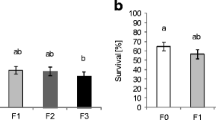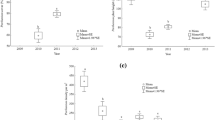Abstract
Vegetation management often involves shredding to dispose of cut plant material or to destroy the vegetation itself. In the case of invasive plants, this can represent an environmental risk if the shredded material exhibits vegetative regeneration capacities. We tested the effect of shredding on aboveground and below-ground vegetative material of five ornamental widespread invaders in Western Europe that are likely to be managed by cutting and shredding techniques: Buddleja davidii (butterfly bush, Scrophulariaceae), Fallopia japonica (Japanese knotweed, Polygonaceae), Spiraea × billardii Hérincq (Billard’s bridewort, Rosaceae), Solidago gigantea (giant goldenrod, Asteraceae), and Rhus typhina L. (staghorn sumac, Anacardiaceae). We looked at signs of vegetative regeneration and biomass production, and analyzed the data with respect to the season of plant cutting (spring vs summer), the type of plant material (aboveground vs below-ground), and the shredding treatment (shredded vs control). All species were capable of vegetative regeneration, especially the below-ground material. We found differences among species, but the regeneration potential was generally still present after shredding despite a reduction of growth rates. Although it should not be excluded in all cases (e.g., destruction of giant goldenrod and staghorn sumac aboveground material), the use of a shredder to destroy woody alien plant material cannot be considered as a general management option without significant environmental risk.

Similar content being viewed by others
References
Bates D, Maechler M, Bolker B, Walker S (2014) lme4: linear mixed-effects models using Eigen and S4. R package version 1.1-5
Beerling DJ, Bailey JP, Conolly AP (1994) Fallopia japonica (Houtt.) Ronse Decraene. J Ecol 82(4):959–979
Bímová K, Mandák B, Pyšek P (2003) Experimental study of vegetative regeneration in four invasive Reynoutria taxa (Polygonaceae). Plant Ecol 166(1):1–11. doi:10.1023/a:1023299101998
Binggeli P, Hall JB, Healey JR (1998) An overview of invasive woody plants in the tropics. School of Agricultural and Forest Sciences Publication (13). University of Wales, Banger
Brabec (1997) Experimental study of the effect of management on invasion of selected plant pieces into meadow communities. Charles University, Prague
Chauvel B, Martinez Q (2013) Allergie à l’ambroisie : quels moyens pour empêcher l’invasion ? Revue Française d’Allergologie 53(3):229–234. doi:10.1016/j.reval.2013.01.033
Child L, Wade M (2000) The Japanese Knotweed Manual. The management and control of an invasive alien weed. Packard, Chichester
Cordazzo CV, Davy AJ (1999) Vegetative regeneration of Panicum racemosum from rhizome fragments on southern Brazilian coastal dunes. J Coast Res 15:520–525
Davies F, Jr, Davis T, Kester D (1994) Commercial importance of adventitious rooting to horticulture. In: Davis T, Haissig B (eds) Biology of adventitious root formation, vol 62. Basic Life Sciences. Springer, New York, pp 53–59. doi:10.1007/978-1-4757-9492-2_4
De Waal LC (2001) A viability study of Fallopia japonica stem tissue. Weed Res 41(5):447–460. doi:10.1046/j.1365-3180.2001.00249.x
Dehnen-Schmutz K, Touza J, Perrings C, Williamson M (2007) A century of the ornamental plant trade and its impact on invasion success. Divers Distrib 13(5):527–534. doi:10.1111/j.1472-4642.2007.00359.x
Delbart E, Pieret N, Mahy G (2010) Les trois principales plantes exotiques envahissantes le long des berges des cours d’eau et plans d’eau en Région wallonne : description et conseils de gestions mécanique et chimique. Gembloux
Delbart E, Mahy G, Weickmans B, Henriet F, Crémer S, Pieret N, Vanderhoeven S, Monty A (2012) Can land managers control Japanese knotweed? Lessons from control tests in Belgium. Environ Manag 50:1089–1097. doi:10.1007/s00267-012-9945-z
Eriksson O (1993) Dynamics of genets in clonal plants. Trends Ecol Evol 8(9):313–316. doi:10.1016/0169-5347(93)90237-J
Gelbard JL, Belnap J (2003) Roads as conduits for exotic plant invasions in a semiarid landscape. Conserv Biol 17(2):420–432. doi:10.1046/j.1523-1739.2003.01408.x
Halford M, Branquart E, Vanderhoeven S, Heemers L, Mathys C, Collin C, Wallens S, Mahy G (2011) AlterIAS: a LIFE+ project to curb the introduction of invasive ornamental plants in Belgium. Aliens: the invasive species. Bulletin 31:36–41
Halford M, Heemers L, van Wesemael D, Mathys C, Wallens S, Branquart E, Vanderhoeven S, Monty A, Mahy G (2014) The voluntary code of conduct on invasive alien plants in Belgium: results and lessons learned from the AlterIAS LIFE+ project. EPPO Bull 44(2):212–222
Harper JL (1977) Population biology of plants. Academic Press, London
Jeník J (1994) Clonal growth in woody plants: a review. Folia Geobotanica 29(2):291–306
Klimesŏvá J, Klimeš L (2007) Bud banks and their role in vegetative regeneration—a literature review and proposal for simple classification and assessment. Persp Plant Ecol Evol Syst 8(3):115–129. doi:10.1016/j.ppees.2006.10.002
Kohlhepp PF, Sanders TG, Tackett CC, Walters RW (1995) Roadside vegetation management. National Technical Information Service, Alexandria
Kowarik I (2011) Novel urban ecosystems, biodiversity, and conservation. Environ Pollut 159(8–9):1974–1983. doi:10.1016/j.envpol.2011.02.022
Lanphear FO, Spangler RL (1996) Weed control in roadside plantings: progress report. Joint Highway Research Project, Indiana Department of Transportation and Purdue University, West Lafayette
Latzel V, Mihulka S, Klimešová J (2008) Plant traits and regeneration of urban plant communities after disturbance: does the bud bank play any role? Appl Veg Sci 11(3):387–394
Levy V, Buchet J, Hauguel J-C, Toussaint B, Valet J-M, Watterlot A (2011) Plantes exotiques envahissantes du nord-ouest de la France. Conservatoire Botanique National, Bailleul
Lin H-F, Alpert P, Yu F-H (2012) Effects of fragment size and water depth on performance of stem fragments of the invasive, amphibious, clonal plant Ipomoea aquatica. Aquat Bot 99:34–40. doi:10.1016/j.aquabot.2012.01.004
Luken JO, Thieret JW (1997) Assessment and management of plant invasions. Springer, New York
Luken JO, Hinton AC, Baker DG (1991) Assessment of frequent cutting as a plant-community management technique in power-line corridors. Environ Manag 15(3):381–388
Martínková J, Klimešová J, Mihulka S (2004) Resprouting after disturbance: an experimental study with short-lived monocarpic herbs. Folia Geobotanica 39(1):1–12
Mulumba LN, Lal R (2008) Mulching effects on selected soil physical properties. Soil Tillage Res 98(1):106–111. doi:10.1016/j.still.2007.10.011
Pasche D (2007) Gestion des plantes exotiques envahissantes dans le canton de Vaud. Centre de Conservation de la faune et de la nature, Vaud
Pasquier J-L (2011) Détermination, lutte et gestion des plantes invasives. Hortic Romande 11:18–23
Pyšek P, Richardson DM (2007) Traits associated with invasiveness in alien plants: where do we stand? In: Nentwig W (ed) Biological invasions. Springer, Berlin, pp 97–125
R Core Team (2014) R: a language and environment for statistical computing. R Foundation for Statistical Computing, Vienna
Randall JM, Marinelli J (1996) Invasive plants: weeds of the global garden. Brooklyn Botanic Garden, New York
Rejmánek M, Pitcairn M (2002) When is eradication of exotic pest plants a realistic goal? In: Veitch CR, Clout MN (eds) Turning the tide: the eradication of invasive species. IUCN, Cambridge, pp 249–253
Seastedt TR, Hobbs RJ, Suding KN (2008) Management of novel ecosystems: are novel approaches required? Front Ecol Environ 6(10):547–553. doi:10.1890/070046
Song Y-B, Yu F-H, Li J-M, Keser L, Fischer M, Dong M, Kleunen M (2013) Plant invasiveness is not linked to the capacity of regeneration from small fragments: an experimental test with 39 stoloniferous species. Biol Invasions 15(6):1367–1376. doi:10.1007/s10530-012-0374-y
Starr F, Starr K, Loope L (2003) Buddleia davidii. United States Geological Survey–Biological Resources Division Haleakala Field Station, Maui, Hawai’i
Tallent-Halsell N, Watt M (2009) The invasive Buddleja davidii (butterfly bush). Bot Rev 75(3):292–325. doi:10.1007/s12229-009-9033-0
Tiébré MS, Bizoux JP, Hardy OJ, Bailey JP, Mahy G (2007) Hybridization and morphogenetic variation in the invasive alien Fallopia (Polygonaceae) complex in Belgium. Am J Bot 94:1900–1910
Verloove F (2006) Catalogue of neophytes in Belgium, vol 39. Scripta Botanica Belgica. National Botanic Garden of Belgium, Meise
Weber E (1998) The dynamics of plant invasions: a case study of three exotic goldenrod species (Solidago L.) in Europe. J Biogeogr 25(1):147–154. doi:10.1046/j.1365-2699.1998.251119.x
Weber E (2011) Strong regeneration ability from rhizome fragments in two invasive clonal plants (Solidago canadensis and S. gigantea). Biol Invasions 13(12):2947–2955. doi:10.1007/s10530-011-9977-y
Weber E, Jakobs G (2005) Biological flora of central Europe: Solidago gigantea Aiton. Flora Morphol Distrib Funct Ecol Plants 200(2):109–118. doi:10.1016/j.flora.2004.09.001
Wittenberg R, Cock MJW (2001) Invasive alien species: a toolkit of best prevention and management practices. CABI International, Wallingford
Wu C-H, Zhai M-P, Wang C (2007) Preliminary study on control and prevention from Rhus typhina. For Invent Plan 6:006
Acknowledgments
The present study was supported by the Public Service of Wallonia. The authors are grateful to Etienne Branquart, Eric Büchler, Mathieu Halford, and Audrey Bourgeois for their helpful comments. All experiments comply with the current laws of the country in which they were performed.
Author information
Authors and Affiliations
Corresponding author
Rights and permissions
About this article
Cite this article
Monty, A., Eugène, M. & Mahy, G. Vegetative Regeneration Capacities of Five Ornamental Plant Invaders After Shredding. Environmental Management 55, 423–430 (2015). https://doi.org/10.1007/s00267-014-0398-4
Received:
Accepted:
Published:
Issue Date:
DOI: https://doi.org/10.1007/s00267-014-0398-4




